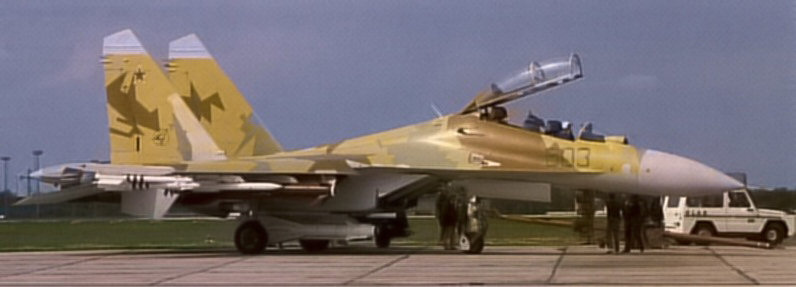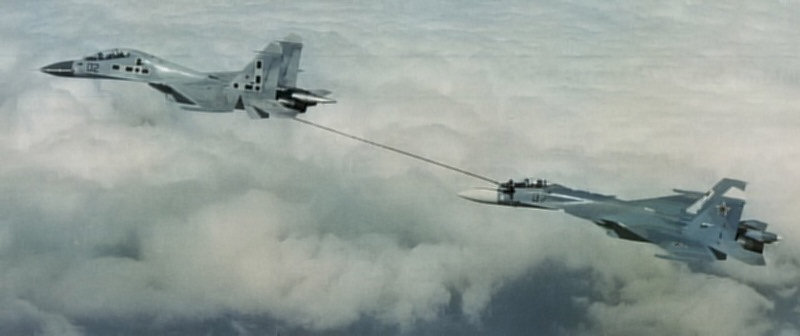The basic Su-27 interceptor and Su-27UB trainer produced a rash of derivatives which were publicly unveiled during the early 1990s. One such derivative was the Su-27PU, which at first glance seemed to differ very little from the Su-27UB trainer. Apart from provision of a retractable inflight- refuelling probe (also fitted to the Su-27K, Su-27KU/IB and Su-27M/Su-35), and with its IRST 'ball' offset to starboard to compensate, the aircraft is externally almost identical. Some analysts hypothesise that the radome is of different profile (perhaps the same as that fitted to the Su-27M/-35), suggesting that a new radar has been fitted. This was denied at the 1993 Paris Air Salon, where the aircraft's designer, Igor Emelianov, confirmed that the Su-30 retains the same radar as the baseline Su-27 interceptor.

This heavily
armed aircraft is one of the demonstrators and development aircraft for
the Su-30MK, the export version of the multi-role version of the original
Su-30 interceptor. India has been mooted as a potential customer for the
aircraft.
The aircraft was designed to meet a PVO requirement for a long-range, high-endurance interceptor that could secure Russia's enormous borders and provide air cover for naval forces. The requirement included a 10-hour endurance stipulation, necessitating provision for inflight refuelling, systems proved for 10 hour's continuous operation and identical twin cockpits housing two pilots, either of whom can assume command at any stage of the mission. Range of the aircraft is given as 3000 km (1,620 nm; 1,864 miles) with internal fuel, and 5200 km (2,808 nm; 3,231 miles) with inflight refuelling. Development funding was ensured by changing the designation to Su-30 (existing aircraft projects being starved of resources). The Su-30 has a new miniaturised navigation system, based on that fitted to Aeroflot's international airliners with a GPS and Loran, Omega and Mars navigation equipment. The prototype made its maiden flight on 30 December 1989 at Irkutsk, in the hands of Yevgeni Revunov. Since then, a small number of production Su-30s have been built, including a pair which was specially constructed to meet an order from the 'Test Pilots' acrobatic team. The latter aircraft were fitted with the IFR probe and navigation system, but lacked all combat equipment and military systems.
The aircraft is reportedly fully combat-capable and, with the addition of extra equipment in the rear cockpit, is also able to operate as a mini-AWACS and command post, operating in conjunction with up to four other aircraft (other Su-30s, Su-27 single-seat fighters, or Su-27Ps), directing or even automatically controlling them to the most suitable target, and transferring information within the formation by datalink to build up the best possible tactical situation display. This is the same concept that has been pioneered by the MiG-31 'Foxhound'. In this role, the Su-30 carries a dedicated fighter controller in the back seat.
The single-seat Su-27P is a less well known aircraft. It is believed to have the same navigation system and increased endurance systems as the Su-30, but its single cockpit would make such capability difficult to exploit operationally. A number of stripped aircraft are operated by the 'Test Pilots' team, but the aircraft's service status is uncertain, and any redesignation must remain a matter of speculation.
The Su-30MK is an export Su-30 derivative for multi-role use with added ground-attack capability. The aircraft remains primarily a long-range interceptor, however, and comparisons with the F-15E have been rejected. The Sukhoi OKB is eager to export the Su-30MK, whose flight test programme was reportedly completed in the early summer of 1993.

One of the Su-30 prototypes refuels the T-10-37, a canard- and hook-equipped forerunner of the Su-27K that lacked folding wings, outboard ailerons and double-slotted flaps.
